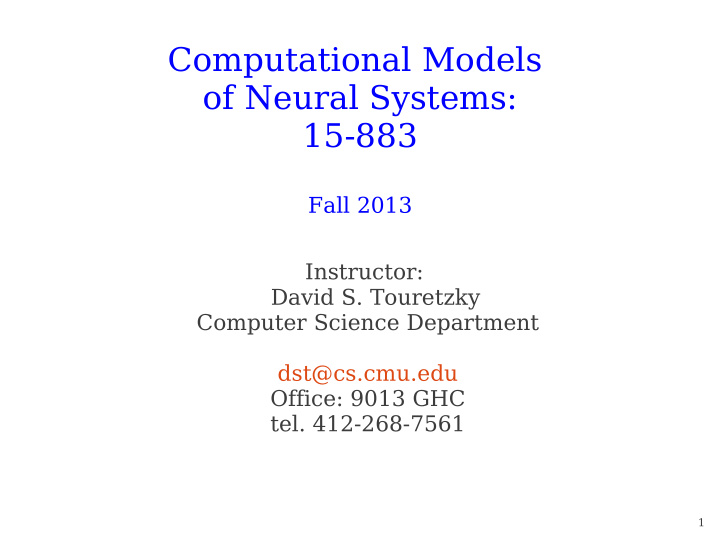



Computational Models of Neural Systems: 15-883 Fall 2013 Instructor: David S. Touretzky Computer Science Department dst@cs.cmu.edu Office: 9013 GHC tel. 412-268-7561 1
Course Info Time: Mon/Wed 4:30 to 5:50 Place: 4101 GHC (G. Hillman Center) Credit: 12 units Current syllabus: on the class web site Textbook: none Readings: Web repository (linked from syllabus) 2
Who Should Take This Course? ● Computer scientists who want to learn about the brain. – No prior neuroscience background required. ● Neuroscientists who want a computational perspective on brain function. – Focus is on representations and algorithms, rather than anatomy and physiology. ● Cognitive scientists who want to study brains as computing devices. – Taking the “brain as computer” metaphor seriously requires learning as much as possible about both. 3
Computational Neuroscience Intellectual Landscape Cognitive Anatomy and Psychology Physiology Computational Neuroscience Dynamical Artificial Neural Systems Theory Network Models Statistics and Information Theory 4
Varieties of “Neural Network” Research 1) Neuronal Modeling 2) Computational Neuroscience 3) Connectionist (PDP) Models 4) Artificial Neural Networks (ANNs) Each area asks a different kind of question. Some investigators work in more than one area. Courses in all four areas are available at CMU or Pitt. 5
1: Neuronal Modeling Understand the operation of single neurons or small neural circuits. Detailed biophysical models of nerve cells, and collections of cells. What makes a neuron spike? Comp. neuro. course at Pitt (Bard Ermentrout, Jon Robin, Churchland & Sejnowski 1988 Math Dept.) 6
2: Computational Neuroscience Model information processing in actual brain systems. The models refer to specific anatomical structures, but their operation may be abstract. How does the hippocampus retrieve memories? Churchland & Sejnowski 1988 15-883 Computational Models of Neural Systems course (Touretzky) 7
3: Connectionist (PDP) Modeling Modeling human cognition in a brain-like way: parallel constraint satisfaction; distributed activity patterns instead of symbols. Models are fairly abstract. How do priming effects act McClelland & Rumelhart 1981 to influence reading? 85-719 PDP models course (Dave Plaut) 8
4: Artificial Neural Nets Pattern recognition, adaptive control, time series prediction. (This is where the money gets made.) Simple, “neuron-like” computing elements; local computation. How can a machine learn to efficiently recognize patterns? 15-782 (Artificial Neural Nets) Pomerleau 1993: ALVINN 9
What's a “Neuron”? w i ∑ x i g y netact = ∑ w i x i = w ⋅ x g(x) is i nonlinear y = g netact 10
Organization of this Course ● Specific domain (e.g., the hippocampus) – Background lecture: anatomy and physiology – Family of models (e.g., associative memory models) ● One or more papers in each family ● Class discussion ● Occasionally: experimentation in MATLAB ● Occasional problem sets ● Modeling project (or term paper) ● Mid-term exam ● Final exam 11
Grading (Approximate Weightings) Problem sets 20% Modeling project 20% (or term paper) Midterm exam 30% Final exam 30% 12
MATLAB You need to learn MATLAB. It's fun! Type “matlab” on Andrew to run it. “peaks” will display this graph; “doc peaks” will tell you about it Student Version of MATLAB: available for Windows/Linux/Mac for $99. Purchase from mathworks.com or CMU bookstore. Pitt students can purchase a license for $10. Tutorials are available online: see the class homepage. 13
What You Should Do Today ● Hand in your student survey questionnaire. ● Read Churchland intro. ● Start learning MATLAB. – Type “demo” for a list of demos, and scroll down to the “Graphics” section. Play around a bit. – We'll have more formal MATLAB instruction later. ● Get started on Wednesday's reading. 14
Recommend
More recommend